Pricing shared for facility upgrades, totals $24 million


Cutline: District residents heard price estimates for proposed updates to the Cadott Junior and Senior High School building, during a facilities information meeting Sept. 8. Each option addresses an identified area of need and the numbers presented are all-inclusive costs. A survey will be mailed to all residents later this fall, to gauge support for each of the projects and prioritize the options.
By Julia Wolf
Updates come at a price. The cost estimates for potential facility upgrades to the Cadott Junior and Senior High building were shared with the public, during a facilities information meeting Sept. 8. The meeting gave the public a chance to get information and ask questions, before a district-wide survey is sent out to gauge support and determine which projects the community sees as top priorities.
The proposed updates fall in line with the district’s strategic plan. Superintendent Jenny Starck says the purpose of a long-range plan, is so they can be efficient with any projects completed.
“As we do these projects, that extends the life of the building that we have,” said Starck.
Lisa Voisin, Baird Public Finance, started the meeting by giving a brief overview of the district’s financials, as it relates to the potential projects. She explained debt is a separate tax levy from the other operations.
“It’s approved by voters,” said Voisin. “You, as community members, will vote yes or no, if the school district can borrow money to upgrade the facilities.”
She says the district has two outstanding loans, both related to the referendum for the elementary school 10 years ago. One loan has a balance of $640,000, at 3 percent, and the other is $7.8 million, at 0.85-2 percent. Voisin says refinancing in 2020, saved taxpayers about $180,000 in interest costs.
She says the reason there is so much principal on the loan, is because it was set up as a wraparound loan. Debt from prior to the elementary referendum was paid off in 2020, before the elementary principal was tackled.
“We were paying interest only,” said Voisin, adding most payments going forward on the current debt will be principal payments, with very little interest due.
The elementary debt is set to be paid off in 2033, and any new debt will likely be set up in a wraparound structure around the elementary debt.
Voisin also talked about the district’s debt limit, which is set at $52 million. She says Cadott is not even close to that, using only 16 percent of that limit, with just over $44 million in debt capacity available. When compared to other districts in the state, Cadott sits roughly in the middle for the percentage of debt capacity they are using.
Voisin then talked about the mill rate, which is a tool to help people calculate the school tax portion on their tax bill. If the mill rate is $11, someone with property valued at $100,000, would pay about $1,100 annually, in school tax.
“Double that, if you have a $200,000 property,” said Voisin.
Voisin says Cadott’s mill rate is predicted to fall again this year, as the district is expected to get more state aid, as property values grow. She showed a graph illustrating how potential new debt levy would fit into the overall picture.
“You’re not going to see a large increase, when you look at where your mill rate’s been in the past,” said Voisin.
Different borrowing amounts and the tax impact of those by mill rate, were also shown.
A $10 million loan would add about five cents on the mill rate, or about $5 extra, per year, for 20 years, on $100,000 worth of property. A $14 million loan would be about $28, per year, on a $100,000 property; an $18 million loan would be $65, per year; and a $24 million loan would be $120, per year.
Voisin says she is using conservative numbers of 5 percent interest rates for her calculations, which will likely change. Once the loan is locked in, it is a fixed-rate loan for 20 years.
Those in attendance reviewed the project options that are in consideration and had time to ask questions about the different projects, before hearing the cost estimates for each project. Craig Uhlenbrauck, Miron Construction, also says the update options are focused on the junior and senior high school, because most elementary needs were addressed in the previous referendum and other elementary needs will be taken care of with other funding sources.
“At this point in the process, these aren’t detailed plans yet,” said Uhlenbrauck.
He says they are trying to get a sense of which projects the community will support and do not want to pay design fees, until they know a project is likely moving forward.
Uhlenbrauck says, accounted for in the project cost estimates, are design and construction, contingencies, inflation, allowances, and equipment and furnishings.
“These are all-inclusive numbers,” said Uhlenbrauck.
Capital maintenance and air conditioning are estimated to cost $5.5 million; a secure entry and main office addition is $3.9 million; kitchen and commons additions and renovations are $3.4 million; tech ed, including an auto lab addition, and art room renovations are $4.7 million; and a fitness and multipurpose space addition is $6.5 million.
“If anyone started doing the quick math in your head, it’ll come out to, roughly, about $24 million,” said Uhlenbrauck, tying back to information Voisin shared earlier in the evening, about the tax impacts of different-sized referendums.
He says it is up to the community to decide if they want to address some areas for the smaller referendum amounts, or if they would like to address everything.
A survey will be sent to all district residents later this fall, likely in early October.





